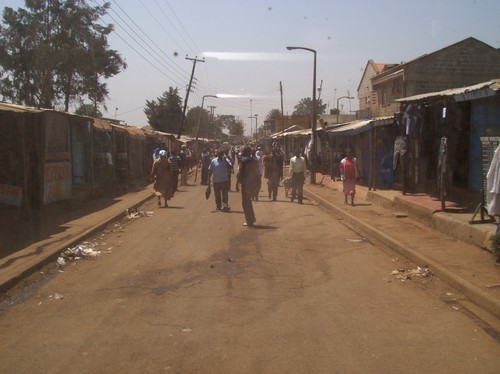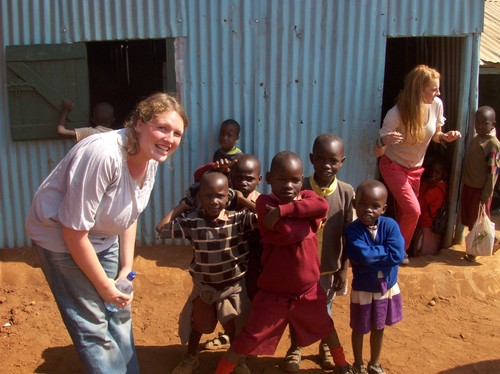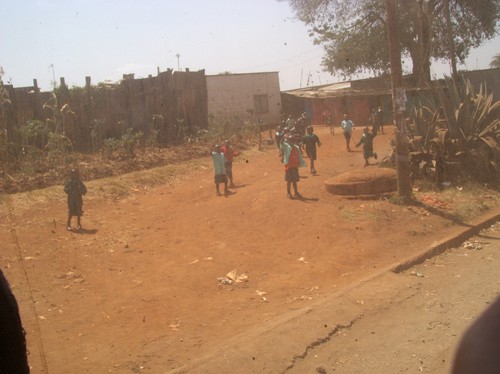Amanda & Gabriel in Kibera
After a week or so of us being here, Gabe and I had the opportunity of joining the older students in their trip to Kibera. Kibera is pretty much just round the corner from the Swedish school. It is actually the second largest slum town in Africa, not just Kenya. I read in a book that there were about a million people living in Kibera, meaning that there are 300.000 people per square km.
At first I was a bit apprehensive about going due to our recent experience of getting on the wrong bus and having to chase another bus through a different shantytown. But now I would not change this experience for anything.
As the mini bus pulled up to drop us off we all wondered how deep in we were. It seemed pretty rough. However, our guide told us that this was a nice shopping area in Kibera and proceeded to lead us all down this very narrow, uneven street. 
Nice shopping area
There was sewage water and rubbish everywhere. The smell was indescribable! We noticed that almost every hut was selling something, whether it was fruit and sweets, or hairdressing services. This must’ve been how most made their living, in their very homes. We crossed an old railway line that was completely covered in litter and looked like it hadn’t been working for several years. We were informed that the line was built 100 years ago as a link between Uganda and Nairobi, and was in fact, still functioning. 
Railway line
The guide also showed us the main river that runs through Kibera. In another setting, and minus the sewage and the foraging pigs this could’ve been a beautiful place. It’s amazing how many amazing things grow in Africa where and when there’s water. We continued up the hill and stood on the spot where only a few years ago, hundreds of people lost their homes and their lives in a horrific mudslide. It seemed so easy for it to just happen again in the next rainy season.
We noticed some pretty new apartments. They looked so out of place here. Our guide told us that they were trying to make Kibera better by renovating sections at a time. In the meantime they would move families into the apartments until their area was better. However, this was proving difficult as it was harder for the residents to sell things from an apartment and so they wished to stay in their huts instead of a safe and clean apartment. Their priorities seem so different here.
We continued on up to a school that the students will be working with in the coming year, and was met by so many school children spilling out of their small, dark classrooms. It was so strange having children so excited to see us and just touch your hand. It was such an eye opener to see how little these children had. The classrooms were too small and they had very little study material. And yet they were happy, and seemed so excited to just kick an empty water bottle around the sand instead of a football. It’s amazing to think that they even had to pay 200ksh (20kr) a month to go there. Even then most children were given that money as a sponsorship because parents were unable to afford it. It just makes you wonder what kind of careers these children could have had if only they had money to give them a better education.
The whole classroom for 26 students
Playtime
The school, Kibera in background
I always presumed that slum towns were for the homeless, but actually not. The people there still have to pay rent, of course very little according to us, but they still have to pay. You see people walking in suits going to work. I’m so surprised how they manage to stay so clean every day in all the heat and dust.
The one thing that will stay fixed in my memory is the happiness and energy that all the children had, and the repeated chants of ‘How are you? How are you?’ that followed us the entire morning’s walk through Kibera.
'How are you? How are you?'
Amanda Samuelsson
